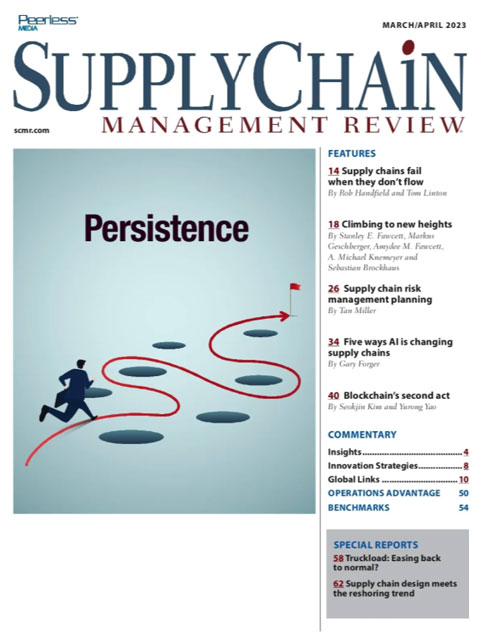Sorry, but your login has failed. Please recheck your login information and resubmit. If your subscription has expired, renew here.
March-April 2023
In June 2013, Frank Quinn stepped down as the only editorial director Supply Chain Management Review had ever known. “In thinking about those whom I’m indebted to for the success of SCMR over 16 years, there is one constituency that must rank first on the list—you, the reader,” Frank wrote, as he handed over the reins to Bob Trebilcock. Now, Bob has done the same, handing over the reins to the next generation. I am very proud to be that next generation. In a farewell letter of sorts, Bob wrote that he was the “old” and I as the “new.” Nothing could be further from the truth. There is no old or new, only continuity. That continuity is… Browse this issue archive.Need Help? Contact customer service 847-559-7581 More options
Ghost lanes are freight lanes contracted to motor carriers that are never used by the shippers that procure them. Research carried out at the MIT Center for Transportation & Logistics (MIT CTL) shows that contracting with carriers to move cargo that never materializes is far more prevalent than is widely assumed and exacts a surprisingly high price for both shippers and trucking companies.
We built a predictive model to identify which freight lanes are the most likely to yield very few or no loads, to estimate how much this outcome costs shippers, and to identify ways the industry can eliminate this profligate practice. Addressing the ghost lane issue may mean changing deep-seated behavior patterns.
Multiple pain points
We analyzed a large data set of shippers’ procurement outcomes and found that about 70% of the lanes procured in a given year end up as ghost lanes in that year. In other words, some 70% of the procurement process for motor freight—a complex process that can take many months to complete—was not needed.

This complete article is available to subscribers only.
Log in now for full access or start your PLUS+ subscription for instant access.
SC
MR
Sorry, but your login has failed. Please recheck your login information and resubmit. If your subscription has expired, renew here.
March-April 2023
In June 2013, Frank Quinn stepped down as the only editorial director Supply Chain Management Review had ever known. “In thinking about those whom I’m indebted to for the success of SCMR over 16 years, there is… Browse this issue archive. Access your online digital edition. Download a PDF file of the March-April 2023 issue.Ghost lanes are freight lanes contracted to motor carriers that are never used by the shippers that procure them. Research carried out at the MIT Center for Transportation & Logistics (MIT CTL) shows that contracting with carriers to move cargo that never materializes is far more prevalent than is widely assumed and exacts a surprisingly high price for both shippers and trucking companies.
We built a predictive model to identify which freight lanes are the most likely to yield very few or no loads, to estimate how much this outcome costs shippers, and to identify ways the industry can eliminate this profligate practice. Addressing the ghost lane issue may mean changing deep-seated behavior patterns.
Multiple pain points
We analyzed a large data set of shippers’ procurement outcomes and found that about 70% of the lanes procured in a given year end up as ghost lanes in that year. In other words, some 70% of the procurement process for motor freight—a complex process that can take many months to complete—was not needed.
 SUBSCRIBERS: Click here to download PDF of the full article.
SUBSCRIBERS: Click here to download PDF of the full article.
SC
MR


More 3PL
- Parcel shipping spend: The untamed holdout in today’s supply chains
- NextGen Supply Chain Conference set for October 21-23
- Penske, NTT Data, CSCMP study finds change still dominates 3PL market
- Estée Lauder, Schneider Electric and S&S Activewear to receive NextGen End User awards
- 2024 Robotics Application Conference announces session, speaker lineup
- NextGen Supply Chain Conference announces Solution Provider Award winners
- More 3PL
Latest Podcast

 Explore
Explore
Business Management News
- Three frameworks for creative problem-solving in supply chain
- Mitigating geopolitical uncertainty: 4 essential tactics for industrial CSCOs
- Supply chain strategy for medical devices: A Q&A with industry expert Sanjay Gupta
- How technological innovation is paving the way for a carbon-free future in logistics and supply chains
- Parcel shipping spend: The untamed holdout in today’s supply chains
- Körber Supply Chain Software’s Craig Moore says MercuryGate acquisition is about the customer
- More Business Management
Latest Business Management Resources

Subscribe

Supply Chain Management Review delivers the best industry content.

Editors’ Picks





